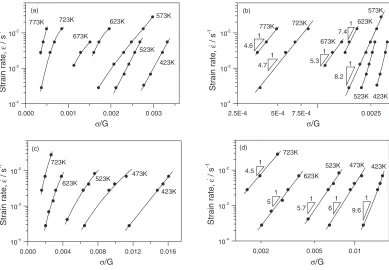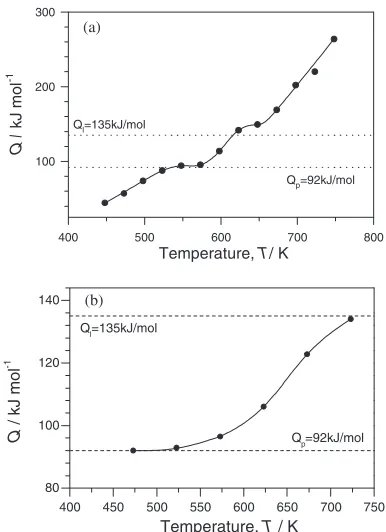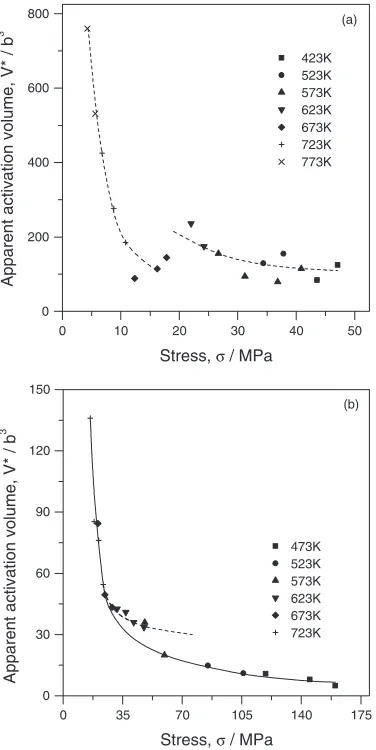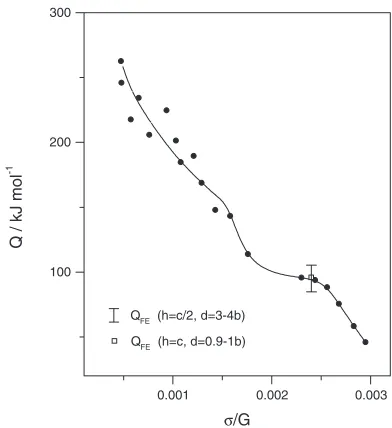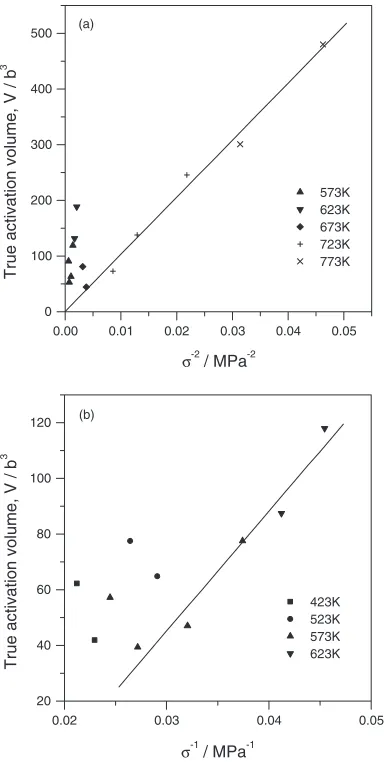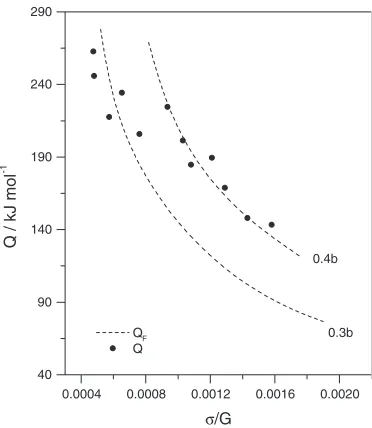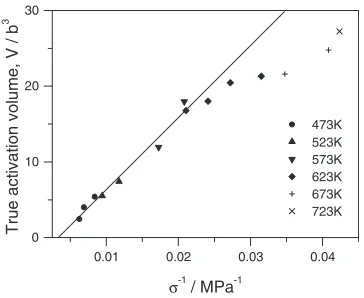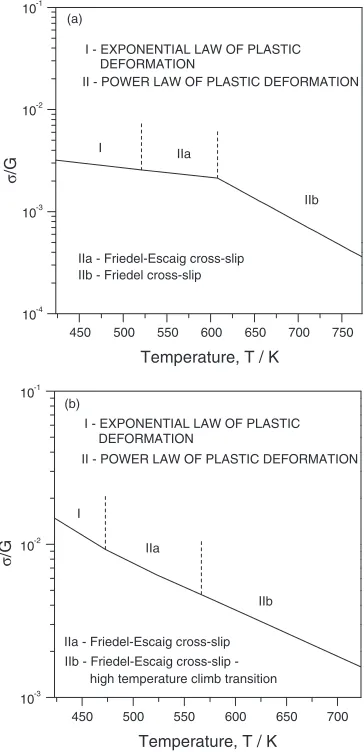Deformation Behavior and Controlling Mechanisms for Plastic Flow
of Magnesium and Magnesium Alloy
Arthur Galiyev
1, Oleg Sitdikov
1;2and Rustam Kaibyshev
1 1Institute for Metals Superplasticity Problems, Khalturina 39, Ufa 450001, Russia 2The University of Electro-Communications, Chofu 182-8585, Japan
Deformation behavior of pure Mg and Mg alloy were studied in the temperature range of 423 to 773 K and at strain rates of104–102s1.
Three temperature regions can be categorized both in Mg and Mg alloy. The deformation behavior in Mg can be described by an exponantional
law at temperatures below 523 K. At the higher temperatures a power law of deformation is valid with the stress exponent close ton¼7in the
intermediate (523–623 K) and 2.2 in the high (673–773 K) temperature ranges. The alloying of Mg with elements such as Zn changes the phenomenology of plastic deformation. An exponantional law is operative at temperatures below 473 K. At above 473 K deformation obeys a
power law. The stress exponent is close ton¼7at intermediate temperatures (473–523 K) and 5 in the high temperature range. An analysis of
experimental results shows that alloying changes the controlling mechanisms of plastic deformation and so leads to different deformation behavior in pure Mg and Mg alloy that can be associated with decreasing stacking fault energy (SFE) in Mg alloy. The effect of SFE on the mechanisms of plastic deformation when alloying Mg is discussed.
(Received October 28, 2002; Accepted November 28, 2002)
Keywords: pure magnesium, magnesium alloy, alloying, deformation behavior, mechanisms of plastic deformation
1. Introduction
Mg alloys are extremely attractive structural materials for application in automotive and aerospace industries because they have unique combination of light weight, high specific strength and stiffness and high recycling capability. How-ever, they exhibit poor workability restricting their commer-cial application. As a result, about 85pct. of articles from Mg-based alloys are fabricated by different casting techniques. One way to extend the commercial use of Mg alloys is to produce wrought Mg alloys with enhanced strength and ductility comparing with cast Mg alloys. Wide implementa-tion of sheet and extruded products from Mg-based alloys into commercial use can lead to new age of Mg in automotive and aerospace industries.1)
Despite growing interest to applications of Mg alloys there exist little information about the behavior of these alloys during plastic deformation, especially concerning tion mechanisms for plastic flow. Examination of deforma-tion characteristics of Mg and Mg-based alloys can be great important from the viewpoint of the detailed physical understanding for character of plastic flow when alloying Mg. Only few creep studies were performed with the cast Mg alloys. The temperature- and strain-rate dependence of the flow stress of the wrought Mg alloys has been investigated only in the Mg alloy, which contained 0.8% Al in solid solution.2) However, 0.8% Al only slightly affect the magnitude of stacking fault energy (SFE) and, therefore, no essential change in the activated deformation mechanisms appeared. Hence, the role of alloying in the character of plastic deformation and resulting mechanical properties of Mg alloys was not fully understood.
Thereupon the comparison of the deformation behavior of a pure Mg and a high-alloyed Mg alloy that has an SFE markedly differing from that of pure Mg is of great interest. Differences between the structural changes occurring upon deformation of Mg and an Mg–5.8%Zn–0.65%Zr (in
weight %) alloy3–5)suggest that the latter may be a suitable object for such a study. Based on these data, we cana priori
assume that alloying Mg with such elements as Zn decreases SFE and, hence, affects the mechanisms for plastic flow. The aim of the present paper is to review the recent works on deformation behavior of commercial grade Mg (with about 0.1% impurities) and the Mg–5.8%Zn–0.65%Zr alloy (ZK60) and to propose a unified view of deformation mechanisms controlling their plastic flow. The role of alloying in a change of SFE and mechanisms of plastic deformation will be discussed.
2. Flow Stress-Strain Curves
Figure1 shows flow stress-strain curves for Mg and the ZK60 alloy.3,6)The plastic deformation leads to essentially higher flow stresses in the ZK60 alloy in comparison with Mg. In Mg the flow stress increases extensively in the low temperature interval 423–523 K as well as in the ZK60 alloy at 423 K. At the higher temperatures (573–623 K in Mg and 473–523 K in the ZK60 alloy), the strain hardening rapidly decreases with increasing temperature. The mechanical behavior at all aforementioned temperatures can be char-acterized by a well-defined peak stress and significant work softening after the peak. At high temperatures (673–773 K in Mg and 573–723 K in the ZK60 alloy), a steady state flow is attained after small strains with little or no softening.
3. The Flow Stress Exponent
The strain rate dependencies of the steady state flow stress in a semilogarithmic scale do not follow a straight line atT
above 523 K in Mg and 423 K in the ZK60 alloy (Fig.2).6,7) At 573 K in Mg and 473 K in the ZK60 alloy, the straight lines are obtained only at high strain rates. At lower strain rates or higher temperatures, the datum points show the linear fits in a double log plot. In general, the steady state flow
Special Issue on Platform Science and Technology for Advanced Magnesium Alloys, II
#2003 The Japan Institute of Metals
behavior can be expressed by a power-law equation
_
"
"s¼A1ðsÞnexpðQ=RTÞ ð1aÞ
The exponent n rises from n¼4:6 at 773 K ton¼8:2 at 573 K in Mg and fromn¼4:5at 723 K ton¼6at 473 K in the ZK60 alloy. The power law brakes down at low temperatures, where the behavior is well represented by an exponential-law equation (Fig.2)
_
"
"s¼A2expðsÞexpðQ=RTÞ ð1bÞ
4. Activation Energy for Plastic Deformation
Temperature dependence of the steady state flow stress does not follow a straight line for both materials (Fig.3).6,7) In Mg the slope of the linear dependence increases gradually with deformation temperature in the range of lower tempera-tures and more rapidly in the range of high ones. In the ZK60 alloy the curve can be decomposed into three regions of constant slope, which smoothly pass from the one into the other.
The activation energy is affected by these changes of the slope of lns-1=T curves (Fig.4).6,7)In Mg three
tempera-Strain, ε / %
0 10 20 30 40 50 60
Stress,
σ /
MPa
0 20 40 60 80
423K
473K
523K
623K
673K
773K 723K 573K
(a)
0 10 20 30 40 50
0 50 100 150 200 250
(b)
.
Strain, ε / % 573K
723K 623K 523K 473K 423K
Stress,
σ
/ MPa
Fig. 1 Flow curves at various temperatures (""_¼2:8103s1). (a) Mg; (b) Mg alloy.
0.000 0.001 0.002 0.003
10-4 10-3
10-2 (a)
423K 523K
573K 623K
673K 723K 773K
.
Strain rate,
ε
/ s
-1
σ/G
2.5E-4 5E-4 7.5E-4 0.0025
10-4 10-3
10-2 (b)
4.6
4.7 5.3
7.4 1
1 1
1
1
8.2 773K 723K
673K
623K 573K
423K
.
523K
Strain rate,
ε
/ s
-1
σ/G
0.000 0.004 0.008 0.012 0.016 10-4
10-3
10-2
.
423K 473K 523K
623K 723K (c)
Strain rate,
ε
/ s
-1
σ/G
0.005 0.01 10-4
10-3 10-2
(d)
0,002
.
9.6 1 6
1 5.7
1 5
1 4.5
1
723K
623K
523K 473K 423K
Strain rate,
ε
/ s
-1
[image:2.595.116.485.74.284.2]σ/G
[image:2.595.104.493.337.607.2]ture regions differing in the Q-T relationship can be distinguished within the given range of strain rates (Fig.
4a). At low temperatures (423–523 K), the activation energy depends almost directly on temperature. In the intermediate temperature range (from 523 to 623 K), the activation energy is constant up to 573 K and then increases to a point of inflection at 623 K. At higher temperatures (673–773 K), the activation energy gradually increases. The activation energy value at high temperatures is two times larger than that in the intermediate temperature range. In the temperature range from 623 to 773 K (particularly, above 673 K), the activation energy increases more intensively with deformation tem-perature than that is observed at 573–623 K. Qualitatively, similar temperature dependencies of Q were reported for aluminum, copper, tin, tungsten, and NaCL.8) However, quantitatively, the dependence calculated for Mg in the present work differs significantly from that obtained in other works. The ratio of the activation energy for plastic flow to that for lattice self-diffusion (QL ¼135kJ/mol) changes
from 0.35 to 2.1 (or from 0.55 to 3.1Qp, whereQp¼92kJ/
mol is the activation energy for pipe-diffusion in Mg). This variation is nearly twice as large as that obtained for other materials.
In the ZK60 alloy the temperature dependence of the activation energy is typical of other materials,8,9)contrary to
that of Mg (Fig.4b). At lower temperatures (473–523 K), the activation energy is close to that for pipe-diffusion in Mg. At high temperatures (573–723 K), the activation energy con-tinuously increases up to Q¼134kJ/mol which is close to that for Mg volume self-diffusion.
5. Activation Volume for Plastic Deformation
The stress variation of activation volumeV is shown in
Fig.5. The V value varies from 760 to 79b3 in Mg7) and
from 136 to 4.9b3 in the ZK60 alloy. Functionally, these
dependencies are typical of many materials2,10–12)in spite of the values ofV estimated for Mg are somewhat lower than
that obtained in other studies.2,11,13)In the same time, some unique features become evident on the curves for Mg and for the ZK60 alloy. At 673 K and at stresses of 14–18 MPa in Mg and at 573 K and at stresses of 50–60 MPa in the ZK60 alloy, the smooth curve breaks down and the datum points can be better extrapolated by the other monotonic curve. This shift on the exponent curves can likely be associated with changes in deformation behavior in Mg and the ZK60 alloy.
6. Dependence of Normalized Data
The phenomenology of plastic deformation indicates that alloying of Mg by Zn changes mechanical behavior and apparently the mechanisms of plastic deformation. Figures6
and 7 show the dependencies of the normalized strain rate
_
"
"kT=DGb on the normalized stress =G for Mg7) and the ZK60 alloy. Three different regimes can be distinguished in Figs. 6 and 7. In low temperature range, the deformation behavior can be described by the exponential law (1b). This range lies between 423 and 523 K in Mg and below 473 K in
1.2 1.4 1.6 1.8 2.0 2.2 2.4 0.5
0.8 1.0 2.5
.
(a)
ε = 2.8×10-3
s-1
10
3 σ
/G
103T-1 / K-1
1.4 1.6 1.8 2.0 2.2 2.4
1 10
(b)
10
3 σ
/G
.
ε = 2.8×10-3 s-1
103T-1 / K-1
Fig. 3 The normalized stress as a function of reciprocal temperature.
(a) Mg; (b) Mg alloy.
Temperature, T/ K
400 500 600 700 800
Q /
kJ mol
-1
100 200 300
Q l=135kJ/mol
Qp=92kJ/mol
400 450 500 550 600 650 700 750 80
100 120 140
Qp=92kJ/mol
Ql=135kJ/mol
Q
/ kJ mol
-1
Temperature, T / K (b)
(a)
Fig. 4 Activation energy as a function of temperature. (a) Mg; (b) Mg
[image:3.595.330.523.71.337.2] [image:3.595.77.264.71.444.2]the ZK60 alloy. The power law (1a) is valid in intermediate temperature interval (523–623 K for Mg and 473–523 K for the ZK60 alloy) and in high temperature interval (673–773 K for Mg and above 523 K for the ZK60 alloy). In the intermediate temperature range, the stress exponent is close
ton¼7for both the materials. In the high temperature range, the stress exponent isn¼2:2in Mg andn¼5in the ZK60 alloy. The normalized stresses corresponding to transition from power-law to exponential-law region are slightly higher than those characteristic of the power-law breakdown according to the Sherby-Burke criterion.8,9) On the other hand, the Sherby-Burke criterion (""kT=DGb_ ¼108), is
close to the critical stress for the transition from high to intermediate temperature range. From these results we can conclude that the deformation behaviors of Mg and the ZK60 alloy are not typical and differed significantly between themselves. The only common feature in ""kT=DGb_ =G
dependencies is the existence of the two ranges of power law and one range of exponential law. However, different magnitudes of the activation energy and stress exponent obtained in the two power-law ranges unambiguously attest to different deformation mechanisms acting in Mg and the ZK60 alloy.
7. Mechanisms of Plastic Deformation
Despite several studies on mechanisms of plastic deforma-tion in pure Mg,8,10,11,13–15)its deformation behavior is still under discussion. The reason is that, to date, the complete and clear view on the deformation behavior of magnesium is hardly available for wide ranges of temperatures and strain rates, and theoretical models applied to explain the deforma-tion behavior are greatly different. Accordingly, the pub-lished data show inconsistencies in both experimental results and their interpretations. Three main points of view on deformation mechanisms are available in literature.
In earlier studies,10,14) dislocation climb was assumed as the mechanism controlling deformation. Milicka et al.14)
reported relatively high the stress exponent, n, and the activation energy,Q, and suggested an original explanation of these data. However, other authors11,13) interpreted the results of Milickaet al.14)to be caused by the presence of fine oxides in the material. At high temperatures, Edelin and
0 10 20 30 40 50
0 200 400 600
800 (a)
423K 523K 573K 623K 673K 723K 773K
Apparent activation volume, V* / b
3
Stress, σ / MPa
0 35 70 105 140 175
0 30 60 90 120 150
(b)
473K 523K 573K 623K 673K 723K
Apparent activation volume, V* / b
3
Stress, σ / MPa
Fig. 5 Apparent activation volume as a function of stress. (a) Mg; (b) Mg
alloy.
σ/G
10-3
ε
kT/D
l
Gb
-12 -8 -4
423K 473K 523K 573K 623K 673K 723K 773K
10 10 10
n=7
n=2.2 .
POWER-LAW BREAKDOWN SHERBY-BURKE
POWER-LAW BREAKDOWN
Fig. 6 Normalized strain rate for magnesium as a function of normalized
stress.
10-3 10-2
10-10 10-9 10-8 10-7 10-6 10-5 10-4 10-3 10-2
.
POWER-LAW BREAKDOWN
POWER-LAW BREAKDOWN SHERBY-BURKE
n=7
n=5
423K 473K 523K 573K 623K 673K 723K
ε
kT/D
l
Gb
σ/G
Fig. 7 Normalized strain rate for magnesium alloy as a function of
[image:4.595.77.265.71.446.2] [image:4.595.328.524.72.286.2] [image:4.595.57.283.502.679.2]Poirier10) obtained an activation energy essentially higher than the self-diffusion activation energy. They attributed this to the development of non-basal slip and an increased activation energy of dislocation climb. These authors reported a low stress exponentn¼2:7.
The other approach was suggested by Vagarali and Langdon.11)The deformation behavior of Mg was examined in a wide temperature-strain rate range. In the temperature range from 600 to 750 K and at stresses higher than 2.5 MPa, the behavior of magnesium is controlled by the development of cross-slip according to the Friedel mechanism.9) The phenomenological analysis of plastic deformation using this approach made it possible to satisfactorily explain the dependencies of the activation characteristics of Mg on the temperature and strain rate, as well as the magnitude of these characteristics. The examination of surface topography and fine structure confirms the conclusions of the phenomenolo-gical analysis.
Further studies of deformation mechanisms in Mg were stimulated by the in situ TEM observations of plastic deformation in the temperature range from 293 to 623 K.13) The deformation of Mg in the temperature range from 423 to 623 K was shown to occur via cross-slip according to the Friedel-Escaig mechanism.16) The microscopic activation parameters calculated usingin situexperimental data agreed well with theoretically predicted ones. At the same time, Couret and Caillard13) noted that different mechanisms should control deformation at higher temperatures. It is noteworthy that this study was performed on single-crystal samples with orientations preventing basal slip. Later, Couret
et al.15)came to the conclusion that cross-slip by the Friedel mechanism could hardly be realized even at high tempera-tures. These conclusions were based on calculations per-formed using a modified Friedel model accounting for the stress-field anisotropy around the dislocation.17)Couretet al.
believe that the only possible mechanism of hot deformation is cross-slip by the Friedel-Escaig mechanism.15)
Hence, there are different interpretations of operating deformation mechanisms in Mg. Moreover, this brief review shows that most of the studies were performed under creep conditions at low strain rates, whereas of more interest are deformation-mechanism maps determining mechanical prop-erties of a material at higher strain rates, i.e., under active loading.
7.1 An examination of deformation mechanisms in magnesium
The phenomenological analysis of plastic deformation in the range of strain rates from 104 to102s1 shows three
temperature ranges differing in the controlling mechanisms for plastic flow. Different theoretical models should be applied to explain the deformation behavior of Mg at low, intermediate, and high temperatures. No single interpretation of deformation processes can be suggested to describe the behavior of Mg in the entire temperature range.8,10,11,13–15)
The deformation behavior of Mg was found to be very complicated at temperatures above 523 K. The approach10,14) explaining this behavior in terms of the transition from high-temperature to low-high-temperature dislocation climb seems to be inconsistent due to the following reasons:
(i) the stress exponent does not obey the rulen¼nþ212)
in passing from the high-temperature to the inter-mediate-temperature range;
(ii) the temperature dependence of activation energy is not typical of this process, namely, one can hardly observe two plateaus in which the activation energy for deformation coincides with Q for pipe and lattice diffusion, respectively.8,18) The activation energy for deformation depends on the normalized stress in a complex nonlinear manner (Fig.8); and
(iii) screw dislocations dominate in magnesium at inter-mediate temperatures, with their edge components being formed as a result of cross-slip.13)
Thermally activated dislocation slip looks like a more adequate interpretation of deformation behavior in Mg. It is well known8,9) that activated cross-slip can occur at high temperatures. This is confirmed by the fact that the activation energy depends on applied stresses.8) Furthermore, earlier studies3,19) showed that slip lines observed at the polished surface of Mg specimens deformed at intermediate and high temperatures are typical of cross-slip. This was supported by the other authors11,13,15) who considered mechanisms of cross-slip in Mg. Attempts to describe the deformation behavior of Mg using other models of thermally activated slip resulted in inadequately low activation energies.11)
To analyze the cross-slip mechanisms in Mg, we will first consider the stress dependence of true activation volume. The apparent activation volume was corrected in the power-law range using the expression suggested by Vagarali and Langdon11)for the cross-slip mechanism of Friedel:
V¼VmRT=; ð2Þ
where m¼2. At temperatures above 673 K, the true activation volume depends linearly on 1=2 (Fig. 9a). In
the intermediate temperature range, this dependence deviates from the straight line. The occurrence of a transition region in the curve of apparent activation volume-applied stresses (Fig.5a) at stresses corresponding to 673 K confirms these
0.001 0.002 0.003
100 200 300
QFE (h=c/2, d=3-4b)
QFE (h=c, d=0.9-1b)
Q / kJ mol
-1
σ/G
Fig. 8 True activation energy in magnesium as a function of normalized
[image:5.595.328.524.71.285.2]estimations. Hence, the dependencies of both the true and apparent activation volumes change functionally upon transition from high to intermediate temperatures.
To estimate the temperature dependence of the true activation volume at intermediate temperatures, we used the approach developed in.13,15,16) The true activation volumeV ¼0:5V, calculated with the assumption that the
Friedel-Escaig mechanism controls deformation15,16) varies inversely with the applied stress (Fig. 9b). However, the datum points reflecting the exponential law do not fit this line. Hence, the mechanisms of plastic deformation are different for the intermediate temperature range and for the low-temperature range.
The fact that the true activation volume depends inversely on applied stresses at intermediate temperatures and on their square at higher temperatures supports the assumption that the cross-slip can control the plastic flow of Mg. In the intermediate temperature range the double Friedel-Escaig cross-slip is the most probable mechanism to act. The complex dependence of the activation energy and the inverse dependence of the true activation volume on applied stresses are typical of this particular mechanism.16) In addition, Couret and Caillard13)observed the action of this mechanism
in situ in Mg specimens oriented for non-basal glide.
Figure10a schematically shows the action of the Friedel-Escaig mechanism.13,15,16)The transition of a screw disloca-tion from one primary slip plane 1 to another primary slip plane 3 occurs sequentially by the recombination, over a length PQ¼L, of the dislocation extended in the primary plane; the emitting of a dislocation loop in cross plane 2 under the action of applied stresses; and the spontaneous splitting in the nearest primary slip plane 3 over a length
P0Q0¼Swith the formation of two edge componentsPP0and QQ0in plane 2. The motion of the latter in plane 2 (as shown
by arrows) moves the dislocation from plane 1 to plane 3. This scheme adequately explains the formation of discontin-uous wavy traces in slip patterns atT >523K.3)Such lines can form as a result of the movement of a dislocations in the basal plane accompanied by numerous transverse displace-ments of these dislocations by interplane spacing.20) We estimate the activation energy according to this model.
From a detailed calculation proposed by Couretet al.15)the activation energy of the Friedel-Escaig mechanism can be given by:
QFE¼2Uhþ2Uh0þ2lEþEelðl;h;SÞ bhðSþlÞ; ð3Þ
where2Uhand2U0hare the energies of two half-constrictions
in the basal plane and cross-slipped segment,15)respectively,
Eis the difference between the energy per unit length of an extended segment in the basal plane and a constricted segment in the cross-slip plane,16) Eelðl;h;SÞ is the elastic
energy of the jog pair with jog heighth, jog lengthland the length of the re-extended segmentS,15)is the resolved shear stress in the cross-slip plane and the last term in eq. (3) represents the external work done in forming the jog pair.
The activation energy calculated at=G¼2:4103and
h¼c=2were 85 and 105 kJ/mol for the3band4bsplitting,
0.00 0.01 0.02 0.03 0.04 0.05 0
100 200 300 400 500 (a)
573K 623K 673K 723K 773K
True activation volume, V / b
3
σ-2 / MPa-2
0.02 0.03 0.04 0.05
20 40 60 80 100 120 (b)
423K 523K 573K 623K
True activation volume, V / b
3
σ-1 / MPa-1
Fig. 9 True activation volume in magnesium as a function of (a) squared
[image:6.595.73.267.71.452.2]reciprocal stress and (b) reciprocal stress.
Fig. 10 (a) Friedel-Escaig mechanism13,15,16) and (b) Friedel
[image:6.595.325.523.71.344.2]respectively (Fig. 8). The changes ofThave only slight effect on QFE. The activation energy remains virtually constant
within the given temperature range.
Thus, comparison of activation characteristics of the deformation behavior of Mg at 523–623 K with theoretical calculations performed according to the Friedel-Escaig model of double cross-slip (Fig.8), which gives a maximum activation enthalpy, shows that the Friedel-Escaig deforma-tion mechanism can be controlling mechanism of plastic flow in the given temperature range.
On the other hand, the activation energy for deformation is close to the activation energy for pipe diffusion (Q¼92kJ/ mol)21) and the stress exponent, n, is equal to 7, which indicates the important role of diffusion-controlled disloca-tion modisloca-tion. It is well known13)that the Friedel-Escaig cross-slip results in the formation and motion of numerous dislocation edge components in non-basal planes. The closeness of the activation energies for thermally activated Friedel-Escaig cross-slip and pipe-diffusion-controlled dis-location climb indicates the importance of disdis-location climb in the plastic flow of Mg in the given temperature range. However, the fact that the range of intermediate temperatures for magnesium lies higher than that corresponding to the Sherby-Burke criterion (Fig.6), makes us estimate such assumptions conservatively.
In the high temperature range 673–773 K, the Friedel cross-slip is more probable mechanism to act. This is confirmed by the following facts:
(1) the true activation volume varies inversely with the squared stress; the corresponding straight line passes through the point of origin (Fig.9a);
(2) the activation energy is inversely related to the applied stresses (Fig.11);11,14)
(3) the experimental stress exponentn¼2:2agrees fairly well with the theoreticaln¼2predicted by the Friedel model.8,9,11,22)
The Friedel mechanism is given schematically in Fig.10b. As distinct from the Friedel-Escaig mechanism, the disloca-tion (in the Friedel model) does not split in the nearest primary slip plane, but forms a loop of critical size in the cross plane. As a result, the constricted dislocation passes into the cross plane as a whole, preserving its screw orientation and covering a considerable distance in this plane
before the reverse transition occurs. In this case, slip patterns should demonstrate long, wavy slip lines, which agrees well with topographic observations at 723 K.3,23)The total energy for this mechanism can be represented as:15,22)
U¼2UhþLEþTesbA; ð4Þ
where2Uhis the energy required to form two constrictions;
LE is the difference between the energy of an extended dislocation segment of lengthLin the primary slip plane and the energy of the identical segment in the cross plane;Teis
the effective line tension of a segment L0 (its length is
increased bys);24)and the fourth term in (4) is the work of bowing of a dislocation segment in the cross plane under the action of applied shear stresses.
Couret et al.15) suggested that the activation energy for Friedel cross-slip may be calculated as follows:
QF¼2Uhþ2L0E=3; ð5Þ
where the critical length of a screw segment in the cross plane
L0 is
L20¼3ðð8TsEÞ=b22ÞððlnðL0=reÞÞ2=ðlnðL0=reÞ 1Þ; ð6Þ
hereTsis the pre-logarithmic anisotropic line tension factor
of a straight screw dislocation andre is an effective cut-off
radius.
Calculations performed for basal-prismatic cross-slip show that the activation energyQFobtained by substituting
experimental (typical of the high temperature range) stresses in (4) can adequately describe the observed increase in Q
only at dislocation widthsd¼0:3bto0:4b, which are small for dislocations split in the basal plane (Fig.12). This contradicts our previous estimates, according to which the dislocation width is 3b. Moreover, Couretet al.15)showed that, with ratio d=b>2, cross-slip cannot be activated at stresses=G<101since, according to the calculated values of QF, the activation energy would be prohibitively large.
0.05 0.10 0.15 0.20
50 250
Experimental data 11)
14)
Q / kJ mol
-1
[image:7.595.334.520.533.747.2]σ-1 / MPa-1
Fig. 11 True activation energy in magnesium as a function of reciprocal
stress in the high-temperature range.
0.0004 0.0008 0.0012 0.0016 0.0020 40
90 140 190 240 290
0.3b 0.4b
QF
Q
Q / kJ mol
-1
σ/G
Fig. 12The activation energy calculated according to the Friedel model15)
[image:7.595.75.263.612.757.2]Since the deformation behavior of Mg in the high-tempera-ture range is typical of the Friedel cross-slip the results of the Friedel and Friedel-Escaig models are not self-consistent.
We assumed that the redissociation of the dislocation in the nearest primary plane occurred with jog heighth¼c=2. However, as it was shown by Couretet al.,15)this leads to serious contradictions between calculated and experimental results. Like authors15)we also took the case for a double jog of heighth¼c. For the double cross-slip mechanism we got a ratio ofd=b¼0:9{1 at normalized stresses =G¼2:4 103(Fig.8) that is in satisfactory agreement with the cross-slip mechanism. The discrepancy can arise from reduced reliability of the linear-elastic treatment when the splitting widths are very small (d/2b). Hence, we conclude that the Friedel and Friedel-Escaig models can adequately describe the deformation behavior of Mg at small splitting widths.
7.2 An examination of deformation mechanisms in magnesium alloy
As we have shown above, the deformation behavior of Mg and the Mg alloy differ markedly. The deformation behavior of Mg at intermediate and high temperatures of deformation can be interpreted only in terms of thermally activated cross-slip. On the other hand, the phenomenology of plastic deformation in the alloy (according to some features) can be explained by both the recovery-controlled deformation and cross-slip mechanisms, similar to Mg. However, there are number of facts that put into question the use of a one model for describing the deformation behavior of the alloy:
(1) the temperature dependence of the stress exponent
n¼nþ2 does not agree with the Sherby-Burke criterion. Raj and Langdon12,25) showed that this phenomenon reflects more complex changes in defor-mation mechanisms. It cannot be explained in terms of the simple transition from volume diffusion as the process controlling deformation to pipe diffusion; (2) direct topographic examination4,6,26,27) attests to the
important role played by cross-slip in the plastic deformation of the Mg alloy at intermediate and high temperatures. This gives us good grounds to consider the thermally activated cross-slip as a mechanism controlling deformation in the Mg alloy as well as in the case of the pure Mg. The distinctions observed in the deformation behavior of Mg and the Mg alloy can be attributed to the effect of alloying on the cross-slip mode;
(3) the typical of the Friedel cross-slip mechanism (ac-cording to which the activation energy strongly depends on stresses) stress exponent n¼2 has not been observed in the alloy in the range of high temperatures as distinct from the pure Mg.
In the intermediate temperature range, the Friedel-Escaig model can satisfactorily explain the deformation behavior of the alloy. This is confirmed by the following facts:
(1) the activation energy depends only slightly on the applied stresses (Fig.13);15)
(2) the true activation volume is inversely related to the applied stresses (Fig.14).
Using the calculation for the corresponding values in eq. (3),QFEwas calculated for the current experiments on the
Mg alloy (Fig.13).6)The splitting widthd=bis unknown, but ford=b¼5,h¼c=2the activation energy in the high-stress (intermediate-temperature) regime gives good agreement with the experimental results.
In the high temperature range, the deformation behavior of the Mg alloy cannot be easily interpreted using this model. The strong stress dependence of activation energy is typical of the Friedel model. In the same time, the stress exponent
n¼5, observed in the alloy at the high temperatures, does not agree with the theoreticaln¼2predicted by the Friedel model.
However, we have good reasons to suggest that at high temperatures the deformation is controlled by the dislocation climb. The magnitudes of the activation energyQ¼135kJ/ mol and stress exponentn¼5indicate the considerable role played by dislocation climb upon plastic deformation of the Mg alloy in the given temperature range. Apparently, the deformation behavior can be considered in terms of the transition from intermediate temperature cross-slip to high temperature climb6) and an effective activation energy for two competing processes can be written as12)
Qc¼ ðQl""_HTþQFE""_FEÞ=ð""_HTþ""_FEÞ; ð7Þ
where ""_HT and ""_FE represent the strain rates for high
temperature climb and Friedel-Escaig cross-slip, respective-ly. These strain rates are given by
0,000 0,002 0,004 0,006 0,008 0,010 60
80 100 120 140
σ/G d/b=4
d/b=5 d/b=6
QFE
Qc
Q
[image:8.595.336.520.72.215.2]Q, kJ/mol
Fig. 13 True activation energy in magnesium alloy as a function of
normalized stress.
0.01 0.02 0.03 0.04
0 10 20 30
473K 523K 573K 623K 673K 723K
True activation volume, V / b
3
σ-1 / MPa-1
Fig. 14 True activation volume in magnesium alloy as a function of
[image:8.595.337.519.278.427.2]_
"
"HT¼A1ðDlGb=kTÞð=GÞ5 ð8Þ
and
_
"
"FE¼A1expðQFE=RTÞð=GÞ7; ð9Þ
whereDlis the appropriate diffusion coefficient, andA1and
are constants. Using eqs. (7) to (9),¼103and the value of
Ql for the diffusion coefficient (D¼D0expðQ=RTÞ, with
D0¼104m2s1for lattice diffusion,21)the magnitude ofQc
was calculated. The dependency of activation energy on stress (Fig.13) is in good agreement with the experimental observations. The temperature dependency of the activation energy in the Mg alloy can, therefore, be associated with the operation of different deformation mechanisms at different temperatures.
8. The Effect of Solid Solution Alloying on the Changes in the Controlling Mechanisms for Plastic Flow
Analysis of deformation mechanisms in Mg and the Mg alloy shows that, despite external distinctions, the deforma-tion behavior of both materials has much in common. In both Mg and the Mg alloy, it is controlled by cross-slip mechanisms in the power-law range. However, the alloying strongly affects the development of cross-slip in the Mg alloy, changing its mode. A theoretical analysis shows that the alloying of Mg with Zn strongly decreases its stacking-fault energy (SFE). As a result, the controlling mechanism for plastic deformation at high temperatures changes from the Friedel to the Friedel-Escaig cross-slip followed by the competing high temperature climb. The splitting of disloca-tions due to a decreased SFE hampers the dislocation recombination at a critical length necessary for the Friedel mechanism to be operative. The activation energy for this process sharply increases, that makes the transition from the Friedel-Escaig to the Friedel mechanism with increasing temperature virtually impossible. This result agrees ade-quately with the effect of alloying on SFE upon the formation of solid solution alloy.28)
The deformation behavior of the Mg alloy at high temperatures cannot be easily interpreted in terms of either recovery-controlled or cross-slip mechanisms. The deviation from a linear dependence of the true activation volume on inverse stresses (Fig. 14) and the direct dependence of the activation energy on applied stresses (Fig.13) contradict with the commonly accepted interpretation in terms of the Friedel-Escaig mechanism. On the other hand, direct topo-graphic observations do not show any essential qualitative changes in cross-slip mechanisms at temperatures of 523 to 723 K.29) The only effect of increasing deformation tem-perature is that the slip at higher temtem-peratures appears to be considerably more homogeneous. With the magnitudes of the activation energyQ¼135kJ/mol and stress exponentn¼5
this gives good grounds to suggest the transition from the cross-slip to dislocation climb controlling mechanism in the high temperature range. The calculation of the activation energy in terms of the transition model gives good agreement of experimental and theoretical data in this range.
From these results we can conclude that the alloying with Zn leads to strongly decreasing role of cross-slip as
controlling mechanism for plastic flow in the high tempera-ture range due to a decreased SFE that causes an insurmoun-table difficulty for the cross-slip. As a result, the dislocation climb in the alloy becomes likely to play the alternative role to the Friedel cross-slip and this changes essentially the deformation behavior in the alloy. Besides the features of the double cross-slip can also be associated with the effect of solid solution alloying. Due to the large difficulty of the dislocation recombination in the Mg alloy the redissociation is likely to occur with smaller jog height than in Mg. This agrees well with the obtainedh¼cfor Mg andh¼c=2for the Mg alloy. In addition the interaction of the cross-slip dislocations with internal stresses originated from solid solution will also contribute to a smaller jog height and the higher stresses in the alloy. The correspondence of the results obtained with the observed influence of alloying and solid solution hardening strongly suggests that the above mechan-isms can actually takes place in Mg and the Mg alloy.
Figure15 summarizes the deformation behavior and the controlling mechanisms for plastic flow of Mg and the Mg alloy on the base of the data analysed. We note that the cross-slip occurring in accordance with Friedel-Escaig mechanism both in Mg and the Mg alloy changes to Friedel mechanism in Mg and high temperature climb in the Mg alloy as the
450 500 550 600 650 700 750 10-4
10-3 10-2
10-1
IIb - Friedel cross-slip IIa - Friedel-Escaig cross-slip (a)
IIb IIa
I
II - POWER LAW OF PLASTIC DEFORMATION DEFORMATION
I - EXPONENTIAL LAW OF PLASTIC
σ
/G
Temperature, T / K
450 500 550 600 650 700
10-3 10-2 10-1
(b)
IIb FriedelEscaig crossslip high temperature climb transition IIa - Friedel-Escaig cross-slip
IIb IIa
I
DEFORMATION
II - POWER LAW OF PLASTIC DEFORMATION I - EXPONENTIAL LAW OF PLASTIC
σ
/G
Temperature, T / K
Fig. 15 A map of deformation mechanisms (""_¼2:8103s1).
[image:9.595.337.519.382.758.2]temperature increase. It is also noted that the temperature can, of course, be exchanged by the strain rate,""_.
9. Conclusions
(1) The deformation behavior and controlling mechanisms for plastic flow of Mg and an Mg–5.8%Zn–0.65%Zr alloy were studied upon active loading in the tempera-ture range from 423 to 773 K and at strain rates ranging from104–102s1.
(2) Three temperature ranges were revealed both in Mg and the Mg alloy differing in activation parameters. (3) In Mg the deformation behavior can be described in
terms of an exponential-law at temperatures below 523 K. In the intermediate temperature range (523– 623 K) and at high temperatures (673–773 K), the deformation obeys the power law. The stress exponent is equal to 7 in the intermediate and 2.2 in the high temperature ranges. The activation energy is constant in the temperature range from 523 to 573 K (Q¼95kJ/ mol) and increases to a magnitude twice as high as the activation energy for the lattice self-diffusion in Mg in the range from 673 to 773 K.
(4) In the Mg alloy a power-law regime is observed at 473– 523 K with a stress exponent of about 7 and an activation energy of about 92kJ/mol. At high tempera-tures of 573–723 K, the value of the stress exponent is about 5, and the activation energy increases to a value close to the activation energy for Mg self-diffusion. (5) The deformation behavior of Mg can be described in
terms of the Friedel-Escaig cross-slip at intermediate temperatures and the Friedel mechanism at high temperatures as controlling mechanisms for plastic flow.
(6) The deformation behavior of the Mg alloy can be associated with cross-slip of dislocations according to the Friedel-Escaig mechanism in the intermediate temperature range and dislocation climb controlled by self-diffusion in the high temperature range.
(7) The alloying Mg with Zn essentially changes the controlling mechanisms for plastic flow. Various mechanisms of cross-slip observed in Mg and the Mg alloy result from the effect of alloying on the width of dislocation splitting. This effect appears at intermediate temperatures as a specific jog height in the double slip process. At high temperatures, the dissociation of dislocations due to alloying hampers the development of the Friedel cross-slip.
Acknowledgements
One of the authors (O.S.) wishes to thank the Japan Society for the Promotion of Science (JSPS) for financial support.
REFERENCES
1) H. Friedrich and S. Schumann: J. Mater. Proc. Techn.117(2001) 276–
281.
2) S. S. Vagarali and T. G. Langdon: Acta Metal.30(1982) 1157–1170.
3) R. O. Kaibyshev and O. Sh. Sitdikov: Fiz. Met. Metalloved.73(1992)
103–114.
4) N. G. Zaripov, A. R. Vagapov and R. O. Kaibyshev: Fiz. Met.
Metalloved.63(1987) 774–781.
5) R. O. Kaibyshev, A. M. Galiyev and B. K. Sokolov: Fiz. Met.
Metalloved.78(1994) 126–139.
6) A. M. Galiyev, R. O. Kaibyshev and G. Gottstein: Acta Mater.49
(2001) 1199–1207.
7) R. O. Kaibyshev, O. Sh. Sitdikov and A. M. Galiyev: Fiz. Met.
Metalloved.80(1995) 174–184.
8) J.-P. Poirier:Creep in Crystals. Deformation Mechanisms in Metals,
Ceramics and Minerals at High Temperature, (Mir, Moscow, 1988) p. 287.
9) J. Cadek:Creep in Metallic Materials, (Mir, Moscow, 1987) p. 304.
10) G. Edelin and J.-P. Poirier: Philos. Mag.28(1973) 1211–1223.
11) S. S. Vagarali and T. G. Langdon: Acta Metall.29(1981) 1969–1982.
12) S. V. Raj and T. G. Langdon: Acta Metall.37(1989) 843–852.
13) A. Couret and D. Caillard: Acta Metall.33(1985) 1455–1462.
14) K. Milicka, J. Cadek and R. Rys: Acta Metall.18(1970) 1071–1082.
15) A. Couret, D. Caillard, W. Puschl and G. Schoeck: Philos. Mag. A.63
(1991) 1045–1057.
16) B. Escaig: Phys. Status Solidi28(1968) 463–474.
17) W. Puschl: Phys. Status Solidi B162(1990) 363–371.
18) H. Luthy, A. Miller and O. Sherby: Acta Metall.28(1980) 169–182.
19) R. O. Kaibyshev and O. Sh. Sitdikov: DAN, Physics-Doclady 333
(1993) 327–330.
20) A. Couret and D. Caillard: Philos. Mag. A59(1989) 783–800.
21) H. J. Frost and M. F. Ashby: Deformation-Mechanism Maps,
(Metallurgy, Chelyabinsk, 1989) p. 328.
22) J. Friedel: Internal Stresses and Fatigue in Metals, (Elsevier,
Amsterdam, 1959) p. 220.
23) R. O. Kaibyshev and O. Sh. Sitdikov: DAN, Physics-Doclady 321
(1991) 306–310.
24) W. Puschl, G. Schoeck and H. O. K. Kirchner: Philos. Mag. A56
(1987) 533–563.
25) S. V. Raj and T. G. Langdon: Acta Metall. Mater.39(1991) 1823–
1835.
26) I. Valeyev, R. Kaibyshev, O. Sitdikov and B. Sokolov: J. Phys.51
(1990) 673–677.
27) R. O. Kaibyshev and B. K. Sokolov: Fiz. Met. Metalloved.74(1992)
99–107.
28) Ya. D. Vishnyakov:Stacking Fault in Crystals, (Metallurgy, Moscow,
1970) p. 215.
29) R. O. Kaibyshev, A. M. Galiyev and B. K. Sokolov: Fiz. Met.
